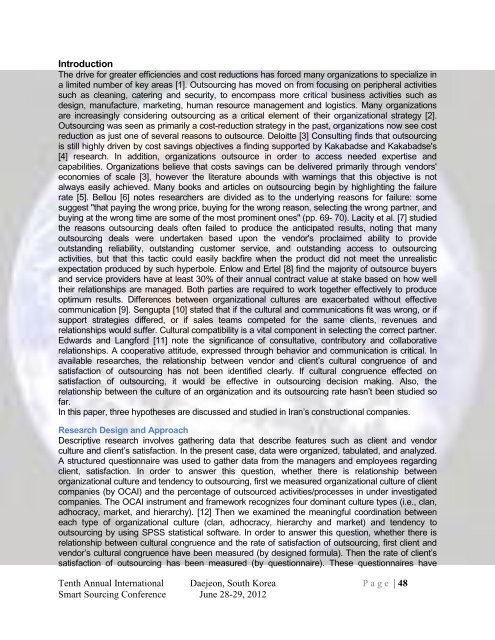of 3 - Center for Global Outsourcings
of 3 - Center for Global Outsourcings
of 3 - Center for Global Outsourcings
Create successful ePaper yourself
Turn your PDF publications into a flip-book with our unique Google optimized e-Paper software.
Introduction<br />
The drive <strong>for</strong> greater efficiencies and cost reductions has <strong>for</strong>ced many organizations to specialize in<br />
a limited number <strong>of</strong> key areas [1]. Outsourcing has moved on from focusing on peripheral activities<br />
such as cleaning, catering and security, to encompass more critical business activities such as<br />
design, manufacture, marketing, human resource management and logistics. Many organizations<br />
are increasingly considering outsourcing as a critical element <strong>of</strong> their organizational strategy [2].<br />
Outsourcing was seen as primarily a cost-reduction strategy in the past, organizations now see cost<br />
reduction as just one <strong>of</strong> several reasons to outsource. Deloitte [3] Consulting finds that outsourcing<br />
is still highly driven by cost savings objectives a finding supported by Kakabadse and Kakabadse's<br />
[4] research. In addition, organizations outsource in order to access needed expertise and<br />
capabilities. Organizations believe that costs savings can be delivered primarily through vendors'<br />
economies <strong>of</strong> scale [3], however the literature abounds with warnings that this objective is not<br />
always easily achieved. Many books and articles on outsourcing begin by highlighting the failure<br />
rate [5]. Bellou [6] notes researchers are divided as to the underlying reasons <strong>for</strong> failure: some<br />
suggest "that paying the wrong price, buying <strong>for</strong> the wrong reason, selecting the wrong partner, and<br />
buying at the wrong time are some <strong>of</strong> the most prominent ones" (pp. 69- 70). Lacity et al. [7] studied<br />
the reasons outsourcing deals <strong>of</strong>ten failed to produce the anticipated results, noting that many<br />
outsourcing deals were undertaken based upon the vendor's proclaimed ability to provide<br />
outstanding reliability, outstanding customer service, and outstanding access to outsourcing<br />
activities, but that this tactic could easily backfire when the product did not meet the unrealistic<br />
expectation produced by such hyperbole. Enlow and Ertel [8] find the majority <strong>of</strong> outsource buyers<br />
and service providers have at least 30% <strong>of</strong> their annual contract value at stake based on how well<br />
their relationships are managed. Both parties are required to work together effectively to produce<br />
optimum results. Differences between organizational cultures are exacerbated without effective<br />
communication [9]. Sengupta [10] stated that if the cultural and communications fit was wrong, or if<br />
support strategies differed, or if sales teams competed <strong>for</strong> the same clients, revenues and<br />
relationships would suffer. Cultural compatibility is a vital component in selecting the correct partner.<br />
Edwards and Lang<strong>for</strong>d [11] note the significance <strong>of</strong> consultative, contributory and collaborative<br />
relationships. A cooperative attitude, expressed through behavior and communication is critical. In<br />
available researches, the relationship between vendor and client’s cultural congruence <strong>of</strong> and<br />
satisfaction <strong>of</strong> outsourcing has not been identified clearly. If cultural congruence effected on<br />
satisfaction <strong>of</strong> outsourcing, it would be effective in outsourcing decision making. Also, the<br />
relationship between the culture <strong>of</strong> an organization and its outsourcing rate hasn’t been studied so<br />
far.<br />
In this paper, three hypotheses are discussed and studied in Iran’s constructional companies.<br />
Research Design and Approach<br />
Descriptive research involves gathering data that describe features such as client and vendor<br />
culture and client’s satisfaction. In the present case, data were organized, tabulated, and analyzed.<br />
A structured questionnaire was used to gather data from the managers and employees regarding<br />
client, satisfaction. In order to answer this question, whether there is relationship between<br />
organizational culture and tendency to outsourcing, first we measured organizational culture <strong>of</strong> client<br />
companies (by OCAI) and the percentage <strong>of</strong> outsourced activities/processes in under investigated<br />
companies. The OCAI instrument and framework recognizes four dominant culture types (i.e., clan,<br />
adhocracy, market, and hierarchy). [12] Then we examined the meaningful coordination between<br />
each type <strong>of</strong> organizational culture (clan, adhocracy, hierarchy and market) and tendency to<br />
outsourcing by using SPSS statistical s<strong>of</strong>tware. In order to answer this question, whether there is<br />
relationship between cultural congruence and the rate <strong>of</strong> satisfaction <strong>of</strong> outsourcing, first client and<br />
vendor’s cultural congruence have been measured (by designed <strong>for</strong>mula). Then the rate <strong>of</strong> client’s<br />
satisfaction <strong>of</strong> outsourcing has been measured (by questionnaire). These questionnaires have<br />
Tenth Annual International Daejeon, South Korea P a g e | 48<br />
Smart Sourcing Conference June 28-29, 2012



